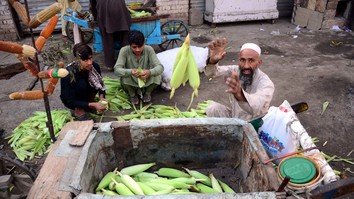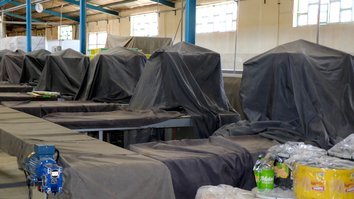PESHAWAR -- The water mill, known locally as a "jranda", employs an ancient mode of grinding wheat, corn, millet and other grains to produce flour.
Jrandas have been around for centuries and are still being used in Khyber Pakhtunkhwa (KP) and other parts of Pakistan, despite the advent of modern technology in grist mills.
Those who know the quality of jranda-produced flour prefer it over flour ground in modern mills, said Hazrat Ali, 50, the operator of a jranda on Warsak Road in Peshawar.
"This is why the jranda has survived; otherwise, it would have withered away because of the onslaught of technology," he told Pakistan Forward.
![Wheat is poured into a hopper for grinding by water-driven, wheel-shaped stones July 6. [Adeel Saeed]](/cnmi_pf/images/2017/07/19/8741-wm7-585_329.jpg)
Wheat is poured into a hopper for grinding by water-driven, wheel-shaped stones July 6. [Adeel Saeed]
Ali's family has been milling flour the traditional way for about a century. He inherited his father's business.
The jranda is operated by flowing water diverted from a river or stream. The force of water flow drives the blades of a turbine. It rotates an axle that drives the crushing stone.
The passage of water is controlled by sluice gates that allow for maintenance and control of the speed of the grinding stones.
This historic way of grinding wheat and other grains is considered a symbol of the rich cultural history of the region, Ali said.
While the mechanics have not changed for centuries, some things have.
All water mills are property of the KP Irrigation Department, which leases them to successful bidders on a yearly basis, Ali said.
"When I started the business, the annual lease of our water mill was Rs. 12,000 ($120)," he said. "This year I bid Rs. 150,000 ($1,500) for the lease."

![A water mill stands over a canal on Warsak Road in Peshawar. Hazrat Ali, who runs the mill, says his family has been associated with this business for 100 years. [Adeel Saeed]](/cnmi_pf/images/2017/07/19/8742-wm1-585_329.jpg)
![Sacks full of wheat lie outside the water mill. [Adeel Saeed]](/cnmi_pf/images/2017/07/19/8743-wm2-585_329.jpg)
![A wheel-shaped crushing stone (with another stone underneath) is shown at the water mill on Warsak Road. In water mills the great spur wheel, operated by the flow of water, turns several other stones to crush wheat, corn and other grains for making flour. [Adeel Saeed]](/cnmi_pf/images/2017/07/19/8744-wm3-585_329.jpg)
![A worker pours wheat into the hopper for grinding by wheel-shaped stones moving in a circle. [Adeel Saeed]](/cnmi_pf/images/2017/07/19/8746-wm5-585_329.jpg)
![Hazrat Ali, operator of the water mill, sifts ground wheat to separate the bran and make the flour finer. [Adeel Saeed]](/cnmi_pf/images/2017/07/19/8748-wm8-585_329.jpg)
![Ali's son Kashif helps his father sift flour. [Adeel Saeed]](/cnmi_pf/images/2017/07/19/8749-wm9-585_329.jpg)
![Hazrat Ali places a flour-filled bag onto a scale. [Adeel Saeed]](/cnmi_pf/images/2017/07/19/8750-wm11-585_329.jpg)







I need a hand mill, where can I get it from?
Reply1 Comment(s)